February itinerary in Japan Day 3 (Hyogo, Tottori Meal edition)
(Friday, February 25)
Table of contents
1. Oishiya Shokudo
I had brunch at Oishiya Shokudo after finishing the walk in Toyooka city. Oishiya Shokudo is a Taishu Shokudo (cheap restaurant) that has been opened in front of Toyooka Station since the early Showa period. It is a typical Taishu Shokudo inside and outside the restaurant. It’s open from 8am to 9pm, so I think it’s a popular Taishu Shokudo for people who arrive at Toyooka Station or depart from Toyooka Station. A very elderly couple was cooking and serving. Being very old, it is slow to move and takes a long time to cook and serve. I think that is also a good part of Oishiya Shokudo.
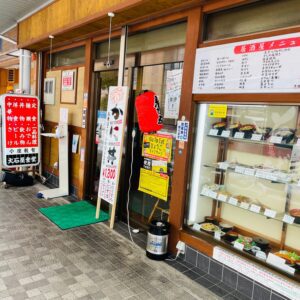

I ordered “Oden” and “Crab bowl” at Oishiya Shokudo. “Oden” has been stewed in an oden pot, so it came out soon. It was a delicious “oden” with the taste soaked in the ingredients.
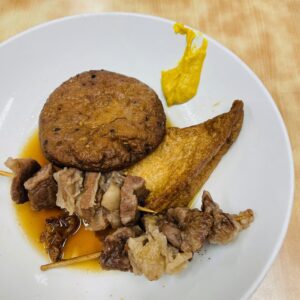
I waited for about 20 minutes until it came out after ordering the “Crab bowl”. The impression is that it took a long time. However, the taste of “crab bowl” was good. The boiled crab legs and eggs were exquisite. “Crab bowl” was Yen 1,300, so I thought the cost performance was reasonably good. Thank you for the meal.

2. Aji-goyomi Anbe
I had dinner at “Aji-goyomi Anbe” after sightseeing in Tottori city. “Aji-goyomi Anbe” was one of the most delicious restaurants I have ever visited in Japan. The cost performance is also very good, and when I came to Tottori City, I definitely wanted to visit it again. The owner was very impressed with the desire to write a menu that changes every day, and even acquired a fountain pen qualification.
At “Aji-goyomi Anbe”, I ordered various sashimi first. The sashimi I ordered was Nodoguro (blackthroat seaperch) sashimi, Hatahata (Japanese sandfish) sashimi, and Sumi Ika (Japanese spineless cuttlefish) sashimi.
As you can see in the picture, the sashimi of blackthroat seaperch was the most delicious sashimi with fat. The skin of the blackthroat seaperch was roasted a little, and its slightly fragrant aroma fits well with the body of the blackthroat seaperch.

I had Japanese sandfish sashimi for the first time in my life. Usually, Japanese sandfish are often baked and eaten, and I also ate grilled Japanese sandfish during my trip to Akita in December and Yamagata in January. This time I challenged the sashimi of Japanese sandfish. It was very greasy and very delicious.

“Hatahata (Japanese sandfish) of Tottori” is “PRIDE FISH” in spring (season: March-May) of Tottori prefecture selected by Japan Fisheries Co-operative. Late February is a little early, but I think it’s the season for Japanese sandfish. Those with a size of 20 cm or more have been selected as “Toro-hata (Fat Hatahata)” (registered trademark in 2013) with more fat and have become a brand. In 2020, Tottori Prefecture was the second largest catch of Japanese sandfish (Hyogo Prefecture was the first).
The sashimi of Sumi Ika (Japanese spineless cuttlefish) was also a very delicious sashimi with the unique sweetness that is characteristic of Japanese spineless cuttlefish. Also, I had squid legs of Japanese spineless cuttlefish with Korean-style spicy sauce. This was also the best. I was already very satisfied with the three sashimi dishes, but after that, I ordered “live snow crab” following yesterday.
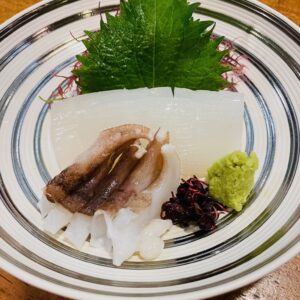
The “live snow crab” of “Aji-goyomi Anbe” was an incredibly good price of Yen 4,500 per crab. When I asked the shop owner, it was a cash purchase, so it was said that they could be purchased at a large discount. I ate “live snow crab” with sashimi and grilled. The sashimi of “live snow crab” was very sweet and delicious like yesterday. After all, I think the most delicious way to eat “live snow crab” is sashimi.

Grilled yaki crab is a way of grilling and eating by yourself. It was the best luxury to bake and eat crab miso in the shell. The owner taught me how to eat crab sashimi with the hot crab miso. When I actually tried it, this was also the best. It was too luxurious to eat.

“Snow crab” is the winter “PRIDE FISH” (season: November-March) in Tottori prefecture selected by Japan Fisheries Co-operative. In Tottori prefecture, fishermen created a new brand “Itsukiboshi” in the fall of 2015. Among the “Snow crab” produced in Tottori prefecture, (1) size: shell width 13.5 cm or more, (2) weight: 1.2 kg or more, (3) perfect shape, (4) bright color, and (5) tightly packed crab meat. Only the excellent ones that have cleared the above will be given the name of “Itsukiboshi”.

After enjoying the “live snow crab”, I ordered sashimi of Mosa-ebi (black small shrimp), Nanbanzuke (marinated in a spicy sauce) of Spanish mackerel and white onions, and boiled liver of blackthroat seaperch.
The black small shrimp is called “Mosa-ebi” in Tottori prefecture and is caught by offshore trawlnet fishery from September to May. It is a phantom shrimp that can only be tasted locally because its freshness deteriorates quickly and it is difficult to ship it to a long distance. It had a sweeter taste and more elastic texture than the northern shrimp, and it was a delicious taste that completely surpassed the sashimi of the northern shrimp. I ate tempura of black small shrimp (called Tsuchi-ebi in Kyoto) at Maizuru last October. The tempura of black small shrimp was also quite delicious, but the deliciousness of the sashimi was far superior to that of tempura.

Compared to the sashimi of Spanish mackerel, the Nanbanzuke (marinated in a spicy sauce) of Spanish mackerel and white onions lacked impact, but they tasted above average. “Spanish mackerel in Tottori” is “PRIDE FISH” in autumn (season: October-March) in Tottori prefecture, which is selected by Japan Fisheries Co-operative. On the day I went, there was no sashimi of Spanish mackerel in the restaurant, so I ordered Nanbanzuke. The next time I go to Tottori, if there is sashimi of Spanish mackerel in the restaurant, I will definitely order it.
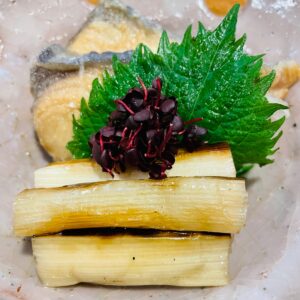
I ate simmered liver of blackthroat seaperch for the first time. According to the owner, the restaurant can not collect a sufficient amount of liver for simmered liver unless it purchases a large amount of blackthroat seaperch. The simmered liver of blackthroat seaperch had a sticky texture peculiar to simmered liver, and the elegant fat of blackthroat seaperch was added, and it was an inspiring taste that goes well with sake.
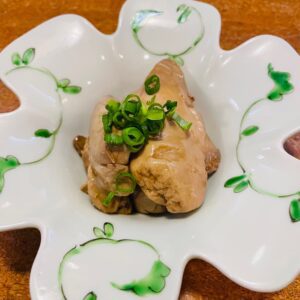
3. Goen
After having the best dinner at “Aji-goyomi Anbe”, I had Horumon-soba at Goen. Horumon-soba is a yakisoba with beef offal that is loved by locals in the eastern part of Tottori prefecture such as Tottori City. In 2010, an organization called “Tottori Horu-soba Customer Center” was established. It is a movement to liven up the city of Tottori with local gourmet food.


Goen is a restaurant where two elderly couples were working together. Compared to the Oishiya Shokudo in Toyooka City, they seemed to be 10 years younger, and they were working vigorously. The Horumon-soba I ate was a very delicious yakisoba with the noodles, offals and sauce entwined exquisitely. I thought this wouldn’t be popular as a local gourmet. With “Aji-goyomi Anbe”, it became a restaurant I would like to visit again.
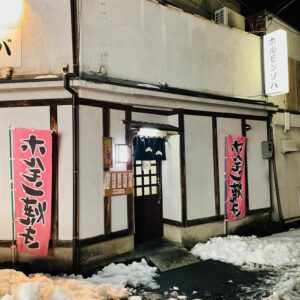
Note: The departure / arrival times, fares of transportation, admission fees, meal fees, etc. listed in the text are as of the time of writing the BLOG. Please check for yourself when you go on a trip as it may change in the future.
